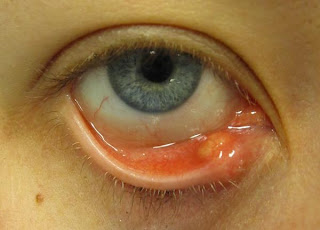WHAT IS CSR?
Central
serous retinopathy (CSR) is a condition of unknown cause in which serous fluid (
thin and serum like fluid ) accumulates underneath the central part of the retina
( light sensitive part of the eye ). This fluid collection is similar to
blisters caused on the skin when exposed to boiling water. This fluid collection
beneath it causes the retina to become elevated. The elevation produces a change
in the layout of the light sensors in the eye leading onto distorted and
blurred vision.
WHO
GETS CSR?
Most
patients with CSR are males in their third and fourth decades. Stress or
corticosteroid use may play roles in inciting or aggravation the condition. Intake
of systemic steroids for Asthma and steroid containing ointments for skin
disorders can also predispose to CSR. Hypertension and Caffeine use has also
been implicated in CSR.
CSR
is more common in anxious and stressed out persons. It can occur after a period
of intense stress like divorce or loss of job.
WHAT ARE THE SYMPTOMS OF CSR?
Many patients first notice a minor
blurring of vision, followed by various degrees of:
- metamorphopsia (defective,
distorted vision)
- micropsia (distorted visual
perception in which objects appear smaller than their actual size)
- chromatopsia (visual defect in
which objects appear unnaturally colored)
- central scotoma
- increasing hyperopia (farsightedness)
Visual acuity in the acute stage may range from 20/20 to 20/200
and averages 20/30. In some patients the onset of symptoms is preceded or
accompanied by migraine-like headaches.
WHAT IS THE NATURAL COURSE OF CSR?
When left alone, central serous retinopathy
heals spontaneously within 4 to 8 weeks, with full recovery of visual acuity. However,
about one-third to one-half of all patients have recurrences after the first
episode of the disease; 10 percent have three or more recurrences. In
almost half of the patients, the recurrence is within one year of the primary
episode, but relapses may occur up to ten years later.
Central serous choroidopathy usually affects
just one eye at a time, but it is possible that both eyes may be affected at
the same time.
WHAT
TESTS MUST BE DONE?
The diagnosis is made by an eye
examination, sometimes using a fundus contact lens. The diagnosis is confirmed
by fluorescein angiography. In
this test, an orange dye is injected into the patient’s vein, and this dye is
observed as it circulates through the ocular vasculature. Typically the
fluorescein enters into the blister and stains its contents, identifying one or
more leakage points. Often, areas of previous retinal pigment epithelial
disruption can be visualized elsewhere in the same eye or in the macula of the
unaffected eye. Ocular coherence tomography (OCT) is another test that is
helpful. This imaging modality can accurately detect fluid and swelling in the
retina.
HOW DO WE TREAT
CSR?
The
typical patient with central serous retinopathy does not require treatment.
Most episodes of this condition are self-limited and resolve within 2 to 3
months. Simple reassurance to the patient that this will occur is beneficial.
In some patients, the subretinal fluid persists for longer than this time
period, and, in this setting, treatment is recommended. Thermal laser can be
applied to the area of the retinal pigment epithelium that is thought to be
playing a role in fluid accumulation. Usually, this treatment is quite
effective and can be very useful when the area of leakage is well away from the
center of vision. Many patients will recover vision back to the 6/6
level, however, patients will often report that vision in the affected eye is
not quite as good as the normal eye even long after the fluid has
resolved. Approximately 25% of patients develop a recurrent
episode. There is also a subset of patients with significant retinal
pigment epithelial abnormalities that are predisposed to attacks in both eyes,
often simultaneously, and the prognosis in this group is much less optimistic,
though with treatment many can maintain reading and driving vision.
WHAT
CAN YOU DO TO PREVENT RECURRENCE?
If
you have had an attack of CSR you have a high chance of having a recurrence. To
lower the risk of recurrence:
- · Learn relaxation techniques like yoga and meditation.
- · Try to find solution to constant stressors in life
- · Exercise daily
- · Totally abstain from smoking
- · Loose body weight if you are over weight



